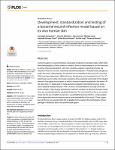Development, standardization and testing of a bacterial wound infection model based on ex vivo human skin
Schaudinn, Christoph
Dittmann, Christin
Jurisch, Jana
Laue, Michael
Günday-Türeli, Nazende
Blume-Peytavi, Ulrike
Vogt, Annika
Rancan, Fiorenza
Current research on wound infections is primarily conducted on animal models, which limits direct transferability of these studies to humans. Some of these limitations can be overcome by using–otherwise discarded—skin from cosmetic surgeries. Superficial wounds are induced in fresh ex vivo skin, followed by intradermal injection of Pseudomonas aeruginosa under the wound. Subsequently, the infected skin is incubated for 20 hours at 37°C and the CFU/wound are determined. Within 20 hours, the bacteria count increased from 107 to 109 bacteria per wound, while microscopy revealed a dense bacterial community in the collagen network of the upper wound layers as well as numerous bacteria scattered in the dermis. At the same time, IL-1alpha and IL-1beta amounts increased in all infected wounds, while—due to bacteria-induced cell lysis—the IL-6 and IL-8 concentrations rose only in the uninfected samples. High-dosage ciprofloxacin treatment resulted in a decisive decrease in bacteria, but consistently failed to eradicate all bacteria. The main benefits of the ex vivo wound model are the use of healthy human skin, a quantifiable bacterial infection, a measureable donor-dependent immune response and a good repeatability of the results. These properties turn the ex vivo wound model into a valuable tool to examine the mechanisms of host-pathogen interactions and to test antimicrobial agents.
Dateien zu dieser Publikation
Keine Lizenzangabe

